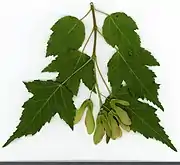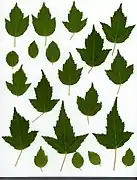| Acer tataricum | |
|---|---|
 | |
| Foliage and fruit | |
| Scientific classification | |
| Kingdom: | Plantae |
| Clade: | Tracheophytes |
| Clade: | Angiosperms |
| Clade: | Eudicots |
| Clade: | Rosids |
| Order: | Sapindales |
| Family: | Sapindaceae |
| Genus: | Acer |
| Section: | Acer sect. Ginnala |
| Species: | A. tataricum |
| Binomial name | |
| Acer tataricum L. 1753 | |
| Synonyms[2] | |
|
List
| |
Acer tataricum, the Tatar maple or Tatarian maple, is a species of maple widespread across central and southeastern Europe and temperate Asia, from Austria and Turkey east as far as Japan and the Russian Far East. The species is named after the Tatar peoples of southern Russia; the tree's name is similarly commonly also misspelled "Tartar" or "Tartarian" in English.[3][4]
Description

Acer tataricum is a deciduous spreading shrub or small tree growing to 4–12 metres (13–39 ft) tall, with a short trunk up to 20–50 centimetres (7.9–19.7 in) diameter and slender branches. The bark is thin, pale brown, and smooth at first but becoming shallowly fissured on old plants. The leaves are opposite and simple, broadly ovate, 4.5–10 centimetres (1.8–3.9 in) long and 3–7 centimetres (1.2–2.8 in) broad, unlobed or with three or five shallow lobes, and matte green above; the leaf margin is coarsely and irregularly toothed; the leaf petiole is slender, often pink-tinged, 2–5 centimetres (0.79–1.97 in) long. The flowers are whitish-green, 5–8 millimetres (0.20–0.31 in) diameter, produced in spreading panicles in spring as the leaves open. The fruit is a paired reddish samara, 10–12 millimetres (0.39–0.47 in) long with a 2–3 centimetres (0.79–1.18 in) wing, maturing in late summer to early autumn.[3][4][5]
Taxonomy
- Subspecies
subspecies accepted by the Plant List maintained by Kew Gardens in London.[5][6]
- Acer tataricum subsp. aidzuense (Franch.) P.C.DeJong
- Acer tataricum subsp. ginnala (Maxim.) Wesm. Japan, Korea, Mongolia, eastern Russia, northeastern and central China
- Acer tataricum subsp. semenovii (Regel & Herder) A.E.Murray - Tibet, Afghanistan, southern Russia, Iran
- Acer tataricum subsp. tataricum - Caucasus, Turkey, Austria, Hungary, Romania, Serbia, Ukraine
- Acer tataricum subsp. theiferum (W.P.Fang) Y.S.Chen & P.C.de Jong - China
Some botanists treat Acer tataricum subsp. ginnala (Maxim.) Wesm. as a species Acer ginnala (Amur maple). Being closely related, they differ conspicuously in the glossy, deeply lobed leaves of A. ginnala, compared to the matte, unlobed or only shallowly lobed leaves of A. tataricum.[3]
Gallery
 Leaf adaxial side.
Leaf adaxial side. Leaf abaxial side.
Leaf abaxial side. Leaf and fruit.
Leaf and fruit. Leaf acer tataricum.
Leaf acer tataricum.
Cultivation and uses
Tatar maple is occasionally grown as an ornamental plant in gardens throughout Europe and also in North America. In Russia, it is valued in farmland shelterbelts.[4] It is locally naturalised in eastern North America.[3][7]
References
- ↑ Crowley, D. (2018). "Acer tataricum". IUCN Red List of Threatened Species. 2018: e.T193877A2288126. doi:10.2305/IUCN.UK.2018-1.RLTS.T193877A2288126.en. Retrieved 16 November 2022.
- ↑ The Plant List, Acer tataricum L.
- 1 2 3 4 Rushforth, K. (1999). Trees of Britain and Europe. Collins. ISBN 978-0-00-220013-4.
- 1 2 3 Ecosystema: Acer tataricum (in Russian; google translation)
- 1 2 Flora of China, Acer tataricum Linnaeus, 1753. 鞑靼槭 da da qi
- ↑ "Acer tataricum L. — The Plant List".
- ↑ "Acer tataricum". USDA Plant Profile. Retrieved October 9, 2007.
